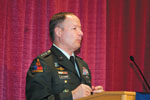International Partners Crucial to Cyber Defense
 |
Gen. Keith Alexander, USA, who leads both U.S. Cyber Command and the National Security Agency, called for greater international partnerships in defending critical networks during his February keynote address at the AFCEA Homeland Security Conference in Washington, D.C. |
Gen. Keith Alexander, USA, director of the National Security Agency and commander of U.S. Cyber Command, is calling for greater international cooperation on cyber defense. “We don’t have a U.S. network, a Canadian network, a Mexican network. It’s all one network. We all operate that, and we have to have international partners to protect it,” Gen. Alexander emphasized.
The general’s remarks reflected on the focus of AFCEA’s February 22-24 Homeland Security Conference in Washington, D.C. The U.S. Defense Department leads the effort to build international cyber partnerships and is making progress with the help of Adm. James Stavridis, USN, supreme allied commander and commander of U.S. European Command, according to Gen. Alexander. Differences in cyber-related laws in varying countries continue to pose significant challenges to building partnerships, but the U.S. Cyber Command has hosted representatives from several allied nations, and some allies are taking the same approach as the United States. “There is no doctrine where each country can say, ‘Here’s my doctrine, here’s my arms, and here’s how I’m going to operate,’” the general explained. “I think the good part is that many of our allies are doing things almost exactly as we are—a cyber command with their National Security Agency (NSA)-like agency partnered together.”
Gen. Alexander warned again that a cyberattack potentially could have devastating effects, and to back up that assertion he cited several network-related disasters in recent years. The 2009 explosion of a massive turbine engine at the Sayano-Shushenskaya dam in Russia, for example, happened when the engine was brought back online remotely with no sensors in place to monitor the situation. “In 2009, the Sayano-Shushenskaya dam was brought online because of massive power failures in other parts of Russia. It was remotely brought online, and when they brought that turbine online—a 15,000-ton turbine—it started to spin, and it went out of control—no remote sensors there. The water that was pushing that thing up raised it 50 feet in the air—15,000 tons—and when it slammed back down, it ended up killing 75 people. The water damage alone wrecked the rest of the facility, which was a major power provider for Russia—all done remotely,” Gen. Alexander said.
He also called for greater cyber situational awareness while protecting civil liberties and said the NSA can be a major player in that endeavor. He lamented the suspicion many citizens have for the NSA and the military, and he revealed that the agency voluntarily “self reports” any and all privacy violations, even if non-U.S. citizens are involved. In addition, the NSA faces a great deal of oversight, according to Gen. Alexander, who called himself “the most oversighted person in the world.
“The only ones not in your networks today are us. There’s no room in there for us,” he joked before turning more serious. “We don’t want to spy. We want to protect the networks. We see this as something absolutely vital to the future of our country.”
In another address, Adm. Thad Allen, USCG (Ret.), revealed that he was in Christchurch, New Zealand during the February 22 earthquake, and he barely made it to the homeland security conference. The admiral complained that too many senior government leaders do not understand today’s technology or social media, and need to “relearn how to learn.”
John Santo, executive director of the U.S. Customs and Border Protection (CBP) agency’s Wireless Systems Program Office, revealed that his organization’s $1.3 billion Tactical Communications Modernization (TacComm) effort faces a number of challenges—so many that agency officials already are looking ahead to a potential follow-on effort, which has been dubbed TacComm Two, to provide truly modern communications technologies, including fourth-generation Internet capabilities and voice, video and data for greater situational awareness.
“TacComm Two is basically a concept, a vision, at this point,” Santo said. “What we hope to do is put in place the latest broadband wireless solutions that the commercial market is offering. We hope to also use the networking architectures that converge voice, data and video on a common data pipe. That’s the kind of wireless tactical environment we need going forward.”
Santo revealed that the current TacComm program does not provide the capabilities required in today’s wireless world. The modernization program is designed to provide the CBP with an upgraded land mobile radio communications system that complies with national interoperability standards and offers advanced standard encryption. About 40,000 agents and officers use the systems. Because many work in remote areas where commercial communications do not exist, their radios offer a lifeline connection to colleagues and headquarters.
“The CBP has a critical need for tactical communications wireless systems. In fact, our frontline, uniformed operational staff rely on tactical communications to do their command and control, to do their coordination with different departments. They use it for situational awareness. Unfortunately, because they’re voice systems, situational awareness is very limited,” Santo said. “The CBP has the largest tactical communications infrastructure in government. We have more than 100 fixed-tower sites and mountaintop sites across the country, mostly in border areas. It’s a huge infrastructure, and in many cases, it’s more than 25 years old.”
But, the land mobile radio systems currently being fielded do not offer a significant technological advancement over the legacy systems being replaced, and they are difficult to operate. “The current project, which I’ll call TacComm One, unfortunately looks a whole lot like the system we are replacing. It’s still voice tactical communications,” Santo explained. “These conventional [very high frequency] land mobile radio systems today have approximately 500 channels programmed into them. There are 1,000 programmable options in each individual channel that we have available to us. They’re very complicated to operate, and it gets even more complicated when we put in interoperability channels that aren’t used every day.”
The projected 10-year, $3.9 billion total life cycle costs also pose significant problems. “Our current funding streams don’t support being able to get this done in 10 years, so by the time we modernize some of these areas, they will have gone to the point that we cannot maintain them any more,” Santo elaborated.
Lack of available spectrum is another issue for TacComm One that likely will worsen as the White House pushes for more spectrum to be made available to the commercial marketplace. Santo said the agency “practically had to beg, borrow and steal” spectrum from across the Department of Homeland Security (DHS) community and even borrowed from agencies outside of the DHS. “It’s a very constrained environment to be able to build the systems that we need from a spectrum perspective,” he added.
Furthermore, even though the current project adheres to established interoperability standards, it does not offer the desired level of interoperability envisioned following the September 11, 2001, terrorist attacks. Because of the limited bandwidth, the radios cannot be programmed over the air. That means, according to Santo, that if the CBP needs to communicate with a local sheriff’s office, it would have to manually reprogram every radio. “We would have to pull 6,000 people off the front lines and manually go through the process to touch with a laptop or loading device every single radio, every mobile, every portable. We would have to go to every mountaintop site. We don’t have any ability with that narrow channel to even program those radios without manually touching them,” Santo lamented.
CBP officials aim to create efficiencies through shared architectures and costs, but they are not waiting for TacComm Two to begin exploring possible solutions. The agency recently released a request for information to explore opportunities for a service-based, shared-infrastructure environment. Ideally, TacComm Two will provide advanced broadband technologies and greater situational awareness to agents in the field. Despite investments already made into unmanned aerial systems and high-resolution surveillance video, the agency has no way to transmit that imagery to agents in the field, let alone allow field agents to send data back to command, control and communication centers. The CBP also intends to push the office environment out to the field, enabling agents in remote places to perform functions—such as gathering biometrics data—that they currently can conduct only in an office.
The CBP has partnered with the DHS science and technology office on a technology demonstration program for mission-critical broadband servers, and the border security organization also is talking to other parts of the DHS, the Department of Justice and state and local officials about partnering on next-generation tactical communications systems.
Photography by Michael Carpenter
WEB RESOURCES
National Security Agency: www.nsa.gov
U.S. Customs and Border Protection: http://cbp.gov/
Department of Homeland Security: www.dhs.gov/index.shtm




Comments